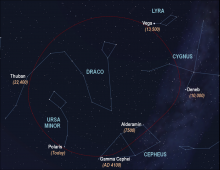Listen to today's episode of StarDate on the web the same day it airs in high-quality streaming audio without any extra ads or announcements. Choose a $8 one-month pass, or listen every day for a year for just $30.
You are here
Moon and Spica
The Moon stands near the middle of the largest member of the zodiac tonight, the constellation Virgo. Spica, the maiden’s brightest star, is close to the Moon as darkness falls, and the Moon will slide a little closer to it during the night. Spica represents an ear of wheat held in the maiden’s hand.
Virgo is the second largest of all the modern constellations. Only Hydra, the water snake, outranks it. But it’s not the size of the constellation that’s made it one of the most important. Instead, it’s the fact that the Sun passes through its borders at the time of the September equinox — the beginning of autumn in the northern hemisphere.
Because of Virgo’s great size, the Sun spends a long time inside its borders — more than seven weeks — from mid-September until the end of October. That’s longer than it stays inside any other constellation.
But the Sun hasn’t always been passing through Virgo at the equinox. Until about the year 730 B.C., it was in the adjoining constellation Libra.
The change is due to precession — a slow “wobble” of Earth’s axis. It takes about 26,000 years to complete one wobble. During that time, the Sun glides through the background of stars. That means the point of the equinox changes as well. It’ll shift over into Leo in about 400 years. And it’ll return to Virgo about 23,000 years after that — returning to the largest constellation of the zodiac.
Script by Damond Benningfield





